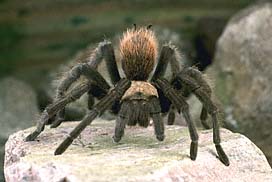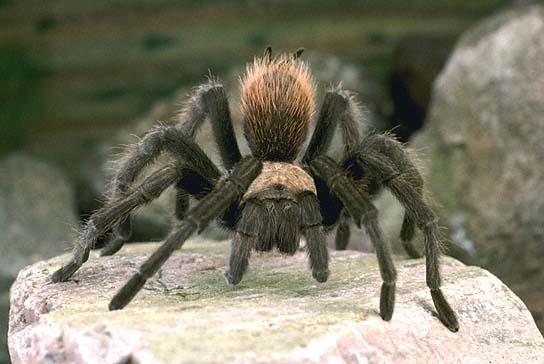Spiders and Harvestmen
Description
Tarantulas are large, hairy spiders, 1 3/8" (33 mm) or more long, with a legspan up to 5 7/8" (150 mm). These spiders have 8 closely grouped eyes; the large middle pair are circular with 3 eyes on each side. Each leg has 2 claws at the tip and a tuft of hair underneath. There are microscopic bristles on the abdomen, which break off easily and can irritate the skin of small mice and other prey. Males have longer legs and are more active than females.
![]()
Warning
Tarantulas have venom that is used to kill prey, but there are no tarantulas in the world that are considered dangerously poisonous to humans. When threatened, all tarantulas will use their hind legs to kick hairs from the upper surface of the abdomen. These hairs cause a burning sensation when they contact sensitive skin or mucuous membranes.
Food
Tarantulas feed mainly on insects and other invertebrates, but will take lizards and small mammals on occasion.
Habitat
Tarantulas are usually found in open habitats; most of the species found in the U.S. are from arid regions.
Range
Throughout the Southwest, into central California and as far north as southern Illinois in the Midwest.
Discussion
Tarantulas are our largest spiders. They spend most of their life underground in a silk-lined burrow. They rest at the bottom by day; after dark they wait near the surface and pounce on insects and other small animals as they wander by. Seldom do they venture more than a few inches from the burrow entrance. They develop slowly, taking between eight and eleven years to reach maturity. Adult males leave their nests during breeding season and wander overland in search of receptive females. Males die soon after mating; in fact, even unmated males seldom live more than a few months after reaching adulthood. Most of the tarantulas encountered by people are males out looking for mates. Females on the other hand may live for many years as adults and can breed several times.


